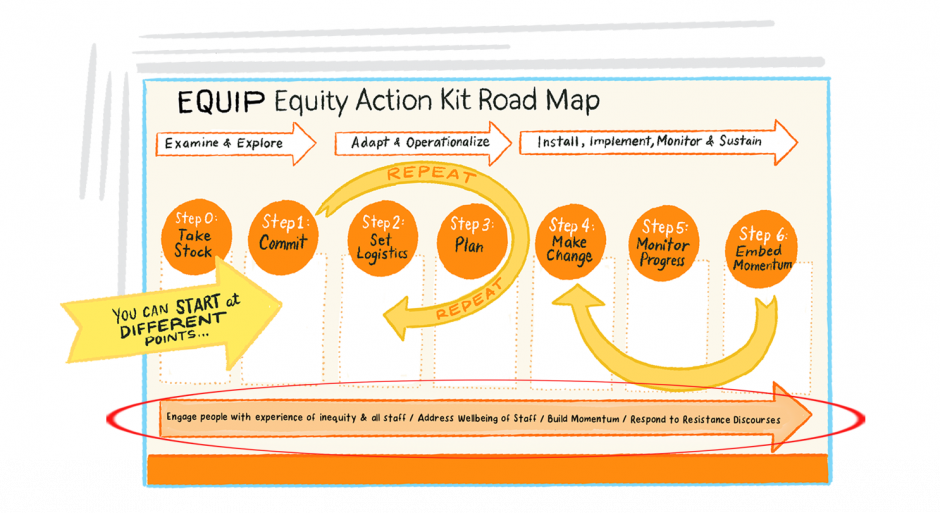5 Things to Do Throughout Your Equity Initiatives


As organizations embark on efforts to promote equity, there are 5 key things to keep in mind. These also need to be considered throughout all steps:
- Engage people with lived and living experiences of inequity
- Engage all levels and types of staff
- Promote the well-being of staff
- Anticipate and respond effectively to resistance
- Build and maintain momentum, including evaluating progress and embedding accountability

1. Engage people with lived and living experiences of inequity
All three key dimensions of equity-oriented care (EOC) require direction from people with lived experiences of inequities. For example, the ‘safety’ in cultural safety or TVIC can only be determined by someone who has felt, and might still feel unsafe, when going for care, or who might not go for care because of how they’re treated. Similarly, substance use health care requires that the goals of care be determined by the person using substances and seeking care.
A great starting point to ensure that the needs of service users drive the process is to partner with key community groups, such as groups concerned with domestic violence, housing, organizations of people who use/d drugs and drug policy advocates, poverty advocates, local Indigenous communities and other communities facing racism and discrimination. They will all share an equity commitment and have considerable experience with community organizing and advocacy for policy and practice change. Further, they will have important insights about what is required for equity-oriented change.
EQUIP has developed a best practice guide for engaging people with lived experience of substance use stigma – this tool (coming soon) could be helpful in thinking about strategies that might work in your context.
2. Engage all levels and types of staff
Interprofessional conversations are the most powerful route to equity-oriented action. For example, in our primary care research, Medical Office Assistants often were the people best able to identify where changes were needed, particularly to make access to care more fair. Including people in roles that are not typically included in decision making (e.g. cleaning staff, security staff, receptionists) will provide a needed diversity of perspectives. Including those with position-power (e.g. leaders, educators, physicians) will add credibility and make the work more visible.
For example, in our Emergency Department work, we sought to support direct care providers to make change toward equity. However, we learned that without engagement and feedback loops to management, staff faced organizational barriers to change that they could not surmount themselves.

3. Promote the well-being of staff:
EOC aims to improve the well-being of staff as well as the well-being of those served. Our research has shown that engaging with efforts to promote equity is rewarding and positive for staff. However, such work is hard. Some of the challenges include:
- Staff becoming overwhelmed or discouraged at the enormity of inequities
- Staff’s own experiences of violence, racism, discrimination and/or stigma may activate a trauma response
- Staff feeling defensive, guilty and angry and possibly resisting change in subtle or not-so-subtle ways
- Staff losing interest or feeling unsupported in their efforts

Include ‘content warnings’: Implementing conversations and education about any of the three dimensions should include warnings for all participants that content or processes may activate a trauma response.
Organizational Supports for Staff: Staff should be encouraged throughout all forms of engagement with equity work to monitor their well-being and access supports. Organizations should promote the use of Employee Assistance Programs and provide ways for managers to support staff, and for staff to engage in self-care strategies, without judgement or stigma. EQUIP has created a Vicarious Trauma tool that outlines ways to recognize this form of trauma and possible strategies that may be of use to you.

4. Anticipate and respond to resistance
Resistance to these kinds of changes is inevitable, and organizations must anticipate when and how this will arise. For example, staff might say things like, “I treat everyone the same”; “systemic racism doesn’t happen here”; or “we’re completely color-blind in my organization”. Similarly, labels often applied to people such as “addict” and “druggie” etc., serve to dehumanize some people and to justify poor treatment- the idea being that some people “don’t deserve” care. It’s important to anticipate these and other forms of resistance, and develop ways to respond constructively and find ‘teachable moments’ – not everyone will come along at the same pace, but most get there, given time and space to adjust their thinking. For specific strategies to prepare for and counter resistance, access the Ensuring Momentum & Accountability: Countering Resistance to Equity Actions tool.
5. Build momentum

Building and sustaining momentum starts with involving as many staff perspectives as possible and taking visible actions as often as possible. Key strategies include:
- Continuously widening the circle of engagement, explicitly using “snowball” strategies to ask who else should and could be involved
- Identifying what is meaningful to people in the setting; for example, what is important to reception staff will differ from what is important to housekeeping or social work staff, and so on
- Inviting each person to contribute in ways that are meaningful to them. For example, people who work with data in your organizations may be key to evaluating progress
- Making the equity work visible on a regular basis, for example posting activities and testimonials in weekly bulletins, all staff emails, and/or on screens in waiting areas, etc.
- Aiming for ‘quick wins’ as well as pursuing long range goals
Using the Action Kit
Use the “Next” and “Back” buttons to navigate through the kit, or by clicking the phase or step you would like to see in the dropdown menu above.

If you would like to read through the materials referenced in this kit click on the book icon.

Useful tools mentioned in this kit can be accessed by clicking on the tool icon.

For helpful resources and links, click on the link icon.

For help on using this Action Kit, click on the question icon.

The “i” icon signals a key point.



